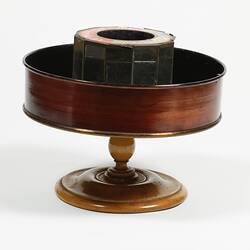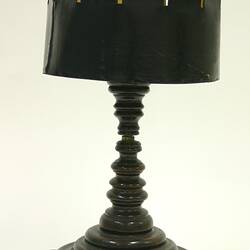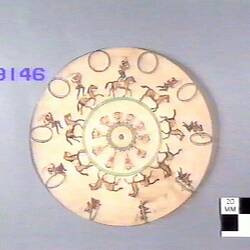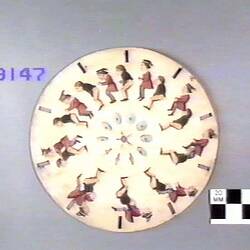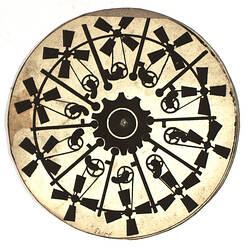The following toys are described here in detail: the Kaleidoscope, the Thaumatrope, the Phenakistoscope, the Zoetrope and the Praxinoscope.
The Kaleidoscope
The kaleidoscope is a tube with an eyepiece at one end. Light enters the other end of the tube. Inside the tube are placed mirrors and small coloured objects, typically beads or glass pieces. As the kaleidoscope is rotated, the mirrors reflect the random mixing of the glass into complex and ordered patterns. The angle of the mirrors determines the number of duplications.
The kaleidoscope was invented by Scottish natural philosopher David Brewster (1781-1868) in 1816. Brewster himself saw the kaleidoscope as an educational instrument, designed to educate the eye and, consequently the mind. In his view only an educated eye could appreciate the wonder of the kaleidoscope.
The word kaleidoscope is derived from the Greek - kalos 'beautiful' + eidos 'shape' + scopein 'to look'.
The Thaumatrope
A thaumatrope is a round disc which has lengths of string attached to each opposite side of its circumference. Each side of the disc has a different but related picture on it, which merge as the disc is spun, creating a simple animation. To spin the disc firstly requires that the strings be twisted. The tension is then released by holding each piece of string and gently stretching them apart, causing the string to unwind and the disc to turn.
The inventor of the thaumatrope has not been credited. However, it was described and popularised by John Ayrton Paris (1785-1856) in 1827.
The word thaumatrope is derived from the Greek and means 'wonder turner'.
The Phenakistoscope
The phenakistoscope uses a series of still images to create an animated image. It consists of a handle to which a disc is attached. The disc has a number of sequential static images upon it. Along the disc's edge there are radial slits. To obtain the illusion of movement, the disc is rotated in front of a mirror, with the viewer looking through the slits at the reflected images.
In 1833, both the physicist Joseph Plateau (1801-1883) in Belgium, and Austrian scientist Simon von Stampfer (1790-1864) independently invented instruments which, using a sequence of individual images, gave the illusion of motion. Both acknowledged Michael Faraday as an influence in their inventions. Plateau coined his invention the phenakistoscope, or fantascope, while Stampfer's creation was named the stroboscope.
The word phenakistoscope derives from the Greek and means 'deceitful viewer'.
The Zoetrope
The zoetrope uses a series of still images to produce an animation. The zoetrope works on the same principles as the phenakistoscope, but where the latter can only be used by one person, the zoetrope allows group viewing.
The zoetrope consists of a cylinder which turns around a central vertical axis. There are slits at regular intervals along the cylinder through which the viewer looks at a series of slightly different static images placed on the opposite inner surface of the cylinder.
Originally called the daedaleum, the zoetrope was developed by William Horner in 1834.
The word zoetrope is derived from the Greek - zoe 'life' + trope 'turn'.
The Praxinoscope
The praxinoscope creates animation through the use of a series of still images. It was an improvement on the zoetrope.
Like the zoetrope the praxinoscope utilises a cylinder, which turns on a central vertical axis. A series of still images are placed on the inner surface of the cylinder. Instead of the narrow viewing slits of the zoetrope, the praxinoscope replaces these with a central drum of flat mirrors. The number of images on the cylinder corresponds with the number of mirrors.
As the outer cylinder is rotated the sequential still images reflected in the mirrors merge to give the appearance of movement. The reflected image created is free of the distortion associated with the zoetrope.
The praxinoscope was invented by Charles-Emile Reynaud in 1877.
In 1879 Reynaud improved on the Praxinoscope with his Praxinoscope Theatre. Essentially the same as the earlier praxinoscope, this new apparatus hid the mechanics of operation from the viewer. The praxinoscope was contained within a box, the hinged lid of which contained the viewing apperture. This apperture aligned with the mirrors of the praxinoscope. A glass pane positioned halfway between the viewing aperture and mirrors was angled so as to reflect scenery cards, which were interchangeable. Effectively the view was that of watching the action on a stage, complete with the proscenium.
The word praxinoscope derives from the Greek and means 'action viewer'.
References:
Mannoni, L., W. Nekes & M. Warner, Eyes, Lies and Illusions, Hayward Gallery with Australian Centre for the Moving Image, London, 2006 [2004].
Morus, I.R., 'Seeing and Believing', Isis, 2006, pp. 101-10.
Myrent, G., 'Emile Reynaud: First Motion Picture Cartoonist', in Film History 3(3), 1989, pp.191-202.
Wade, N.J., Perception and Illusion: Historical Perspectives, Springer, New York, 2005.
http://courses.ncssm.edu/gallery/collections/toys/html/exhibit11.htm Accessed 31 July 2009.
Online Etymology Dictionary http://www.etymonline.com/index.php?search=kaleidoscope&searchmode=none Accessed 28 August 2009
More Information
-
Keywords
-
Authors
-
Article types

